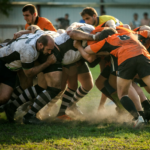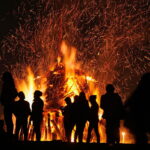Hello everyone, and welcome to an exciting entry about Halloween! Today, we're diving into the eerie and intriguing history of Halloween, a celebration filled with costumes, candies, and a dash of spookiness. Let's explore the origins of this unique holiday together!
Halloween has ancient roots, dating back to a Celtic festival called Samhain, celebrated over 2,000 years ago. The Celts lived mostly in the area that is now Ireland, the United Kingdom and northern France. Samhain marked the end of summer and the beginning of winter, a time when the boundaries between the living and the dead were believed to blur. They believed that the veil between life and death was at its thinnest and that ghosts and ghouls could visit the land of the living.
This was also the time when the pagan priests made offerings to their deities to protect themselves and their crops from evil spirits.
By the 9th century, the influence of Christianity had spread to Celtic lands, where it gradually blended with the older Celtic rituals. In 1000 A.D., the church commemorated All Saints' Day on November 1st to remember all saints and martyrs during Christian history. It is followed by All Souls' Day on November 2nd to honour the dead. It’s widely believed today that the church was attempting to replace the Celtic festival of the dead with a related, church-sanctioned holiday.
As America became more and more colonised and an influx of immigrants entered the country and brought their traditions with them, Halloween slowly morphed into what it is today; dressing up, trick or treat and a fun day all round.Over time, Halloween lost most of its superstitious and religious overtones by the beginning of the twentieth century.
When we think of Halloween however, certain symbols come to mind. The jack-o'-lantern, for instance, has a fascinating history. Originally, people carved turnips, not pumpkins! Ghosts are, of course, another iconic symbol, as well as the black cat. The history of witches and their black cats are so interesting that they should be their own podcast! It’s the main reason why they were burnt at the stake!
Famous book characters are also a staple for the season; Frankenstein and Dracula coming straight out of old classic English novels.
Today, Halloween is not just about ancient traditions. It's a big deal nowadays, with celebrities going all-out with their costumes, decorations in homes and public spaces, and spooky or grotesque movies."
Films and pop culture have played a huge role in shaping our modern Halloween celebrations as well. Think of classics like 'Halloween' and 'The Nightmare Before Christmas.'"
But let's not forget the commercial side of Halloween – the reality is that it’s become a consumerist holiday that fills the shops with new items every year.
To sum it up, Halloween has a rich and fascinating history that's a blend of ancient customs, religious influence, and modern fun. It's celebrated around the world in various ways, and it's a time for costumes, candy, and scary stories."
As Halloween approaches, I encourage you to explore your local festivities, learn more about the history of Halloween, and maybe even try carving your own jack-o'-lantern. Learning English can be a thrilling journey, especially when you explore topics as intriguing as Halloween."
Thanks for joining us today on Daway Experience. There are a lot of interesting new words for some of you so if you’d like to see the transcript, you can find it on our website. Until next time, keep exploring, keep learning, and keep having fun with your English journey!"
VOCAB BANK:
Eerie misterioso | Intriguing intrigante | Dash of Spookiness una pizca de espanto | Ancient roots raíces antiguas | Dating back se remonta a | Blur entremezclarse | Veil velo (separación en este caso) | Ghouls demonios | Blended mezclado | Commemorate conmemorar | Martyrs martires | Church-sanctioned autorizado por la iglesia | Influx flujo | Morphed se transformó | Overtones connotaciones | Carved tallado | Turnips nabo | Burnt at the stake quemado en la hoguera | Staple básico, esencial, muy importante | A big deal un asunto importante | Go all-out darlo todo | Grotesque grotesco | Play a huge role desempeña un papel esencial | Rich rica | Thrilling emocionante, apasionante
COMPREHENSION QUESTIONS
- What is the historical significance of Samhain in relation to Halloween, and how did it influence the way Halloween is celebrated today?
- How did Christianity impact the development of Halloween, and what church-sanctioned holidays were created in response to Celtic traditions?
- Describe the evolution of Halloween from its early origins to modern times, including the changes in its cultural and religious aspects.
- Why were turnips initially carved for Halloween instead of pumpkins, and what is the significance of the jack-o'-lantern as a symbol of Halloween?
- How has Halloween become a commercialized holiday, and what are some examples of the commercial aspects mentioned in the blog?
- What was the main purpose of the Celtic festival of Samhain?
a) Celebrating the summer season
b) Honoring saints and martyrs
c) Marking the transition from summer to winter
d) Commemorating ancient deities - In what way did Christianity influence Halloween?
a) By discouraging the celebration of Halloween
b) By incorporating Celtic rituals into Christian holidays
c) By abolishing all pagan traditions
d) By introducing new rituals unrelated to Celtic traditions - Which of the following best describes the evolution of Halloween over time?
a) It retained its superstitious and religious elements throughout history.
b) It started as a commercial holiday and later incorporated religious rituals.
c) It began as a Celtic festival and gradually lost its religious and superstitious aspects.
d) It was always a secular holiday and did not undergo significant changes. - Why did people originally carve turnips for Halloween, as mentioned in the blog?
a) Pumpkins were not available in Celtic regions.
b) Turnips were considered more traditional for the holiday.
c) Turnips were believed to ward off evil spirits.
d) Pumpkins were considered too sacred to carve. - According to the podcast, which of the following factors has contributed to the commercialisation of Halloween?
a) The influence of pop culture and movies
b) A resurgence of religious traditions
c) A decrease in the number of immigrants celebrating Halloween
d) A shift toward more superstitious and traditional customs



